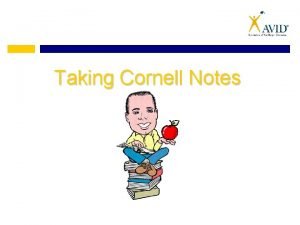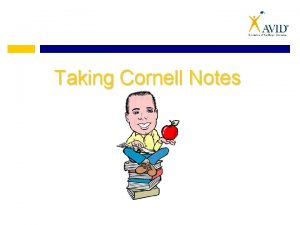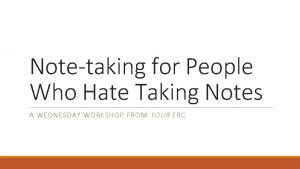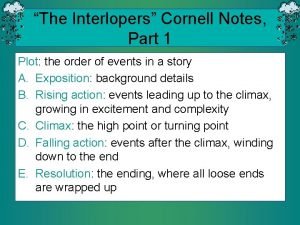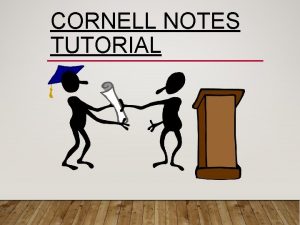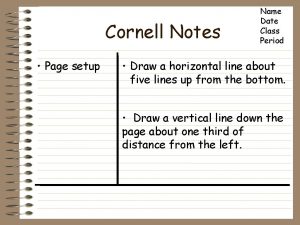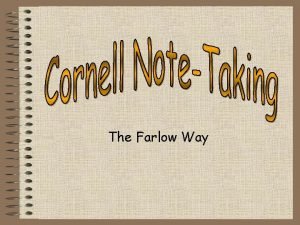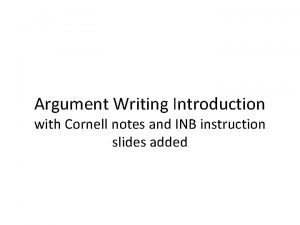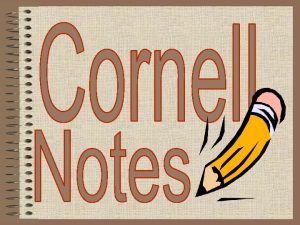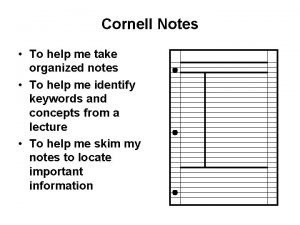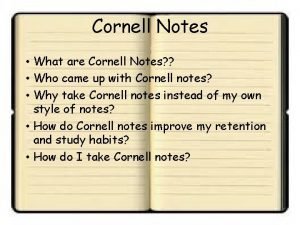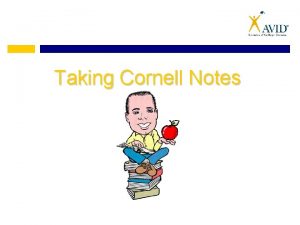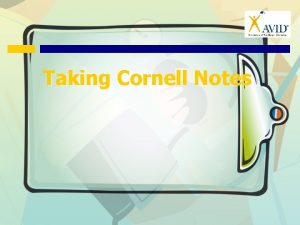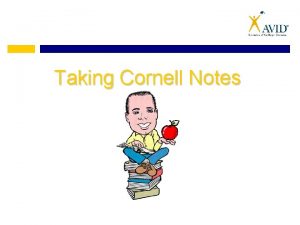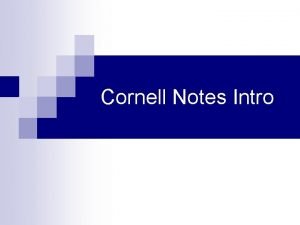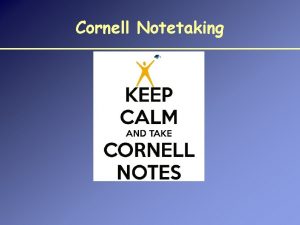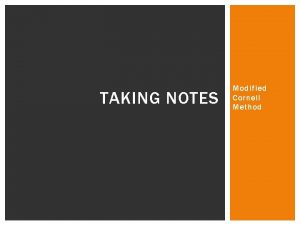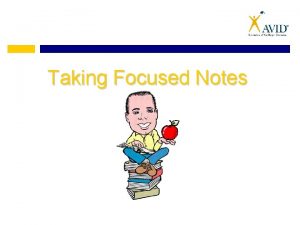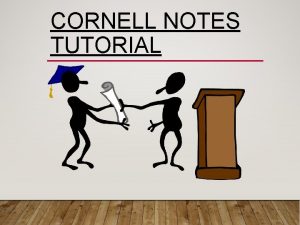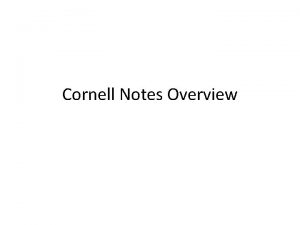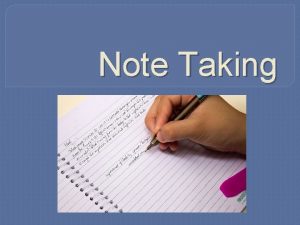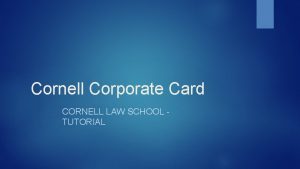Taking Cornell Notes What do Cornell Notes Look


























- Slides: 26

Taking Cornell Notes

What do Cornell Notes Look Like?

The Curve of Forgetting • By day 2, if you do not think about or review your notes, you will lose 50%-80% of what you learned. • By day 30, if you do not think about or review your notes, you remember only 2% - 3% of what you learned on day 1. Source: Counseling Services, Study Skills Program at the University of Waterloo

The Value of Cornell Notes • Students who take no notes or some notes retain less than 59% of what was learned. • Students who take and use Cornell Notes as a study tool retain 90%-100% of what was learned.

Table Talk • With your table group, discuss when you should take notes in class. • Make a list. • Be prepared to share with the class!

When to Take Notes • The speaker says to take notes • The speaker says something you don’t already know • The speaker presents using Powerpoint • The speaker writes on the board • The teacher says, “This will be on the test. ”

S. T. A. R. • Set up your paper • Take the notes • Apply your thinking to the notes • Reflect on Revise and Review your notes.

Set Up Your Paper • Put a proper heading in the top right corner. – Name – Class – Period – Date • Save 1/3 of the left hand side of paper for questions by folding or drawing a vertical line. • Write the topic of the lecture, passage, etc in the form of an essential question.

Set Up Your Paper

Take Notes • Write notes on the right side of the page • Abbreviate words • Paraphrase • Skip at least 2 lines between each idea • Use symbols, pictures, or diagrams

Take Notes

Apply Your Thinking • Within 24 hours of taking notes, review your notes and write questions on the left side of the page.

Reflect on Notes • Add a summary to your notes. Answer the essential question as your topic sentence and turn each “chunk” of information into supporting sentences.

Revise Notes • Review notes with a partner and add details that you each missed. v v

Revise Notes • Look in your textbook and add details from the book to your notes. v v

Review Notes • Fold your notes so that the questions show, but the notes do not. Quiz yourself or work with another student to quiz each other.

Cornell Note Requirement • Students are required to take at least 3 pages of Cornell Notes per class per week (3 pages x 5 classes = 15 pages) • You may choose any 5 classes to take notes for (no notes are required for P. E. )

What counts as a page of notes? • Each side of the paper counts as a page of notes. If you write on both sides of a paper, that counts as two pages of notes. • A learning log counts as a page of notes (see next slide)

Learning Logs • Students may write up to 3 learning logs per week in place of 3 pages of Cornell Notes • A learning log is a 5 sentence summary of what you learned in class that day. • Learning logs work well when notes aren’t given in class Learning Log Today in Scholars, I learned that sometimes Cornell notes aren’t the best option. Learning logs are the best option when there is not a lecture. Some examples of when to write learning logs include: days when we have group projects, presentations, a performance, a guest speaker, etc. I can only write up to 3 learning logs per week. Learning logs count as part of the required 15 pages of Cornell notes. Name Class Period Date

CSG Forms Count as Notes • Option #1: #1 Place completed CSG forms in your binder in the appropriate section. For example, if the CSG notes are about math, you can put the CSG form in the math section of your binder. • Option #2: #2 You may use completed CSG forms (for any subject) as notes for your Scholars elective class. • Each completed two-sided CSG form will count as 1 page of notes for binder checks.

Sample Cornell Notes (Scholars 9)

Sample Cornell Notes (Integrated Math I)

Sample Cornell Notes (Spanish I)

Sample Cornell Notes (English 9)

Sample Cornell Notes (Integrated Science I)

Optional Templates • Visit www. thescholarsprogram. weebly. com for optional templates. Cornell Notes Template (for Math) Learning Log Template
 Look down to the right
Look down to the right What does cornell notes look like
What does cornell notes look like What do cornell notes look like
What do cornell notes look like Cornell note taking strategy
Cornell note taking strategy Cornell note taking method
Cornell note taking method Cornell note taking strategy
Cornell note taking strategy Minion taking notes
Minion taking notes I hate taking notes
I hate taking notes Picture analysis activity 1
Picture analysis activity 1 Activity 1 a look at the picture
Activity 1 a look at the picture Activity 3.picture analysis
Activity 3.picture analysis Cornell notes the interlopers
Cornell notes the interlopers The cornell way
The cornell way Cornell notes steps
Cornell notes steps Cornell notes chemistry
Cornell notes chemistry Cornell notes history
Cornell notes history Biology cornell notes
Biology cornell notes Cornell notes youtube
Cornell notes youtube Parts of cornell notes
Parts of cornell notes Point of view in the interlopers
Point of view in the interlopers Cornell notes setup
Cornell notes setup Cornell notes setup
Cornell notes setup Cornell notes definition
Cornell notes definition How to set up cornell notes
How to set up cornell notes Declaration of independence cornell notes
Declaration of independence cornell notes How does cornell notes work
How does cornell notes work Cornell notes example
Cornell notes example

